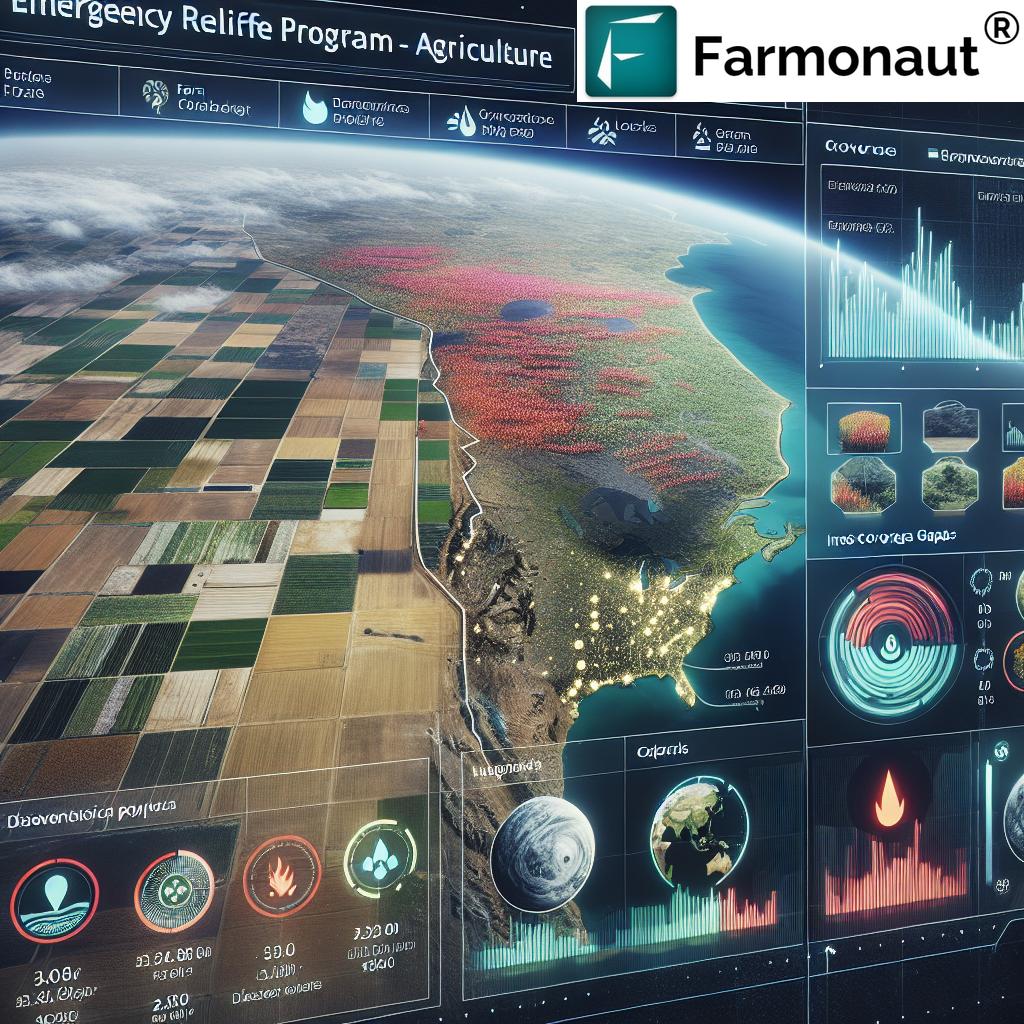Agricultural Yields Data API Access: Boost US Farm Insights
- Introduction: The Power of Agricultural Yields Data API Access
- Trivia: US Farm API Adoption
- Understanding Agricultural Yield Data
- How APIs Revolutionize Agricultural Data Access
- Key Sources of Agricultural Yield Data APIs in the US
- Farmonaut’s Satellite-Driven Farm Intelligence & API Ecosystem
- Top Benefits of Using Agricultural Yields Data APIs
- Comparison Table: Agricultural Yields Data API Features and Benefits
- Challenges and Considerations in API-Driven Data Integration
- Future Outlook: Where Agricultural Data APIs Are Headed
- FAQ: Agricultural Yields Data API Access
- Get Started with Farmonaut & API Access
“Over 80% of US farms use yield data APIs to optimize crop management and resource allocation.”
Introduction: The Power of Agricultural Yields Data API Access
In today’s rapidly digitalizing agricultural landscape, agricultural yield data has emerged as an essential resource for everyone involved in farming—from farmers and agribusinesses to researchers and policymakers. Open agricultural datasets—now easily accessible through advanced APIs—are revolutionizing the way we manage crops, allocate resources, and ensure sustainable agriculture practices, particularly for US farms. The integration of real-time crop data via agriculture data APIs supports smart decision-making, fosters environmental stewardship, and boosts productivity across the agriculture sector.
However, the journey from scattered statistics to actionable, field-ready insights has been complex—until the rise of application programming interfaces (APIs). APIs serve as crucial connectors, enabling seamless access to yield statistics, weather patterns, soil quality analysis, and more, directly supporting farm resource management and precision farming practices.
In this comprehensive guide, we’ll explore how agricultural yields data API access boosts US farm insights, examine the leading data sources and providers, dive into the enabling technologies, and demonstrate why advanced, API-driven solutions like Farmonaut’s are paving the way for the future of farming.
Understanding Agricultural Yield Data
Agricultural yield data is a cornerstone for crop management, farm planning, and sector-wide strategic decisions. But what exactly does agricultural yield mean, and why is it so pivotal to modern agriculture?
Definition and Key Metrics
- Yield refers to the amount of a specific crop harvested per unit area (commonly bushels per acre or tons per hectare).
- This metric is central to assessing crop performance, determining profitability, and benchmarking the productivity of agricultural operations.
- Yields are measured after accounting for factors such as post-harvest losses, and the data is often aggregated by area, crop, and season.
The accuracy of yield statistics impacts resource allocation, financial planning, and even national food security policies. Reliable agricultural data also underpins sustainable agriculture practices and long-term sector growth.
Factors Influencing Yield
Yield outcomes are shaped by a broad spectrum of factors:
- Soil quality: Fertility, composition, and structure play a decisive role
- Climate conditions: Temperature ranges, weather patterns, and rainfall frequency
- Farming practices: Tillage, planting density, fertilizer and pesticide application
- Pest management and disease control
- Technology utilization: Precision agriculture tools, sensors, and data analytics
In advanced farm management systems, integrating open agricultural datasets with on-field sensor data and remote sensing inputs delivers precise yield estimates, stress detection, and boosts efficiency.
The Value of Real-Time and Historical Data
- Real-time crop data provides immediate insights into current field conditions, allowing for agile decision-making during the growing season.
- Historical datasets enable the assessment of yield trends over time, which is critical for research and strategic planning.
- This dual approach empowers farmers, agronomists, and policymakers to develop data-driven solutions for the ever-changing landscape of US agriculture.
How APIs Revolutionize Agricultural Data Access
Application programming interfaces (APIs) have disrupted the traditional, laborious processes of data collection and analysis in agriculture. When it comes to agricultural yields data API access, APIs bridge the space between complex data sources and easy-to-use applications, ensuring all stakeholders—from individual US farmers to large agribusinesses—can access and harness the data they need for actionable insights.
What Is an API in the Context of Agriculture?
- An API is a protocol that allows software applications to communicate and share data in an automated, standardized way.
- In agriculture, APIs serve as “data pipelines” that enable farm management platforms, dashboards, and analytics tools to integrate with external data sources, such as government databases or satellite systems, without manual intervention.
Why Do APIs Matter for US Farms?
- APIs offer seamless, programmatic access to yield statistics, field-level satellite imagery, weather data, and soil quality details.
- They eliminate repetitive, time-consuming data downloads, thus freeing up resources for strategic, high-value analyses.
- These interfaces also fuel the next generation of precision agriculture, underpinning automated systems and smart farm resource management.
Example Applications of Agricultural Data APIs:
- Smart Irrigation: Automatic irrigation scheduling using integration of soil moisture and weather forecast APIs.
- Yield Forecasting: Near real-time prediction of field output by combining historical crop yield datasets and live satellite imagery.
- Pest Detection: Early warning of pest invasions by analyzing spatio-temporal data patterns fed via open APIs.
- Regulatory Compliance: Simplified crop insurance verification using API-fed satellite data for fast, transparent claim approval. Learn more about Farmonaut’s crop loan & insurance verification solutions.
Key Sources of Agricultural Yield Data APIs in the US
Unlocking valuable insights for crop management and data-driven farming analytics begins with accessing reputable data sources. Below are some of the most important open agricultural datasets and API providers in the United States, each contributing to the agricultural data ecosystem.
1. United States Department of Agriculture (USDA) APIs
-
NASS Quick Stats API (data.nass.usda.gov):
– Provides comprehensive crop yield statistics, acreage, and production data on county, state, and national levels.
– Highly customizable for farm performance assessment and year-over-year analyses.
– Ideal for policy, academic, and enterprise-grade agricultural data integration. -
ERS Farm Data APIs (ers.usda.gov):
– Delivers programmatic access to Agricultural Resource Management Survey (ARMS) data, covering financial and operational statistics on US farms.
– Useful for benchmarking, market analysis, and research into resource use across the agriculture sector.
2. Farm Land Data API
- Farm Land Data API provides geospatial analytics—such as soil data, historical weather information, topographic and land resource details—for any parcel in the Continental US. This enables granular analysis for informed land management and sustainable planning.
3. Global Open Data for Agriculture and Nutrition (GODAN)
- GODAN is a key initiative promoting global agricultural data sharing. Through collaboration, the GODAN community makes open agricultural yield datasets, crop statistics, and nutritional data available via APIs for research, policymaking, and agri-tech solutions.
“Open agricultural datasets have improved yield prediction accuracy by up to 25% in tech-driven US farms.”
Farmonaut’s Satellite-Driven Farm Intelligence & API Ecosystem
At Farmonaut, we believe technology should empower growers and agribusinesses with accurate agricultural yield data and powerful, real-time decision-making tools. Through our advanced satellite-based platform and robust API suite, we enable the agricultural community to seamlessly access, analyze, and integrate open agricultural datasets and field-specific insights into their workflow.
Our Technology Stack
- Satellite-Driven Crop Monitoring: High-resolution, multispectral imagery powers real-time crop health analysis and precision yield estimation.
- Artificial Intelligence Advisory (Jeevn AI): Dynamic, data-driven crop management strategies, customized for every field and weather scenario.
- Blockchain-Based Traceability: Ensures full transparency and data security throughout the agri-food supply chain.
- Fleet & Resource Management: Maximize resource utilization and reduce operational costs for machinery, vehicles, and labor.
- Carbon Footprinting & Sustainable Agriculture: Live environmental impact tracking for eco-conscious compliance and reputation building.
With Farmonaut’s API access, developers, agriculture professionals, and organizations can integrate weather data, satellite crop monitoring, and historical yield statistics directly within their existing farm management systems.
- Visit our API Developer Documentation for integration and customization instructions.
- Need solutions for large, multi-site operations? Discover Farmonaut Large Scale Farm Management: offering scalable precision monitoring across portfolios.
- For advisory on forest plantations and specialty crops, explore our Plantation Advisory Features.
This modular, subscription-based approach maximizes flexibility and ensures every stakeholder—farmers, researchers, agribusiness leaders, and institutional clients—gets timely, actionable agricultural yield information, whenever and wherever it’s needed.
Top Benefits of Using Agricultural Yields Data APIs
The widespread adoption of agricultural yields data APIs across the US farm sector speaks to their power and versatility. Here’s how API-driven data access is transforming modern farming systems:
- Enhanced Decision-Making: Real-time, accurate data on crop health, soil quality, and field conditions empowers farmers to make nimble, informed choices—for planting, irrigation, fertilization, and harvesting.
- Efficient Farm Resource Management: Datasets enable resource optimization, ensuring every drop of water, every ounce of fertilizer, and every labor hour is used effectively while minimizing wastage and environmental impact.
- Smarter Policy Development: Policymakers and government agencies can formulate evidence-based agriculture policies and support programs thanks to transparent, aggregated, and regularly updated statistics.
- Boosted Research and Innovation: Researchers leverage open data for trend analysis, development of new crop varieties, and modeling solutions that enhance productivity and sustainability.
- Sustainable Agriculture Practices: Ongoing access to field-level analytics encourages adoption of environmentally optimal farming practices and compliance with sustainability standards.
Comparison Table Showcasing Agricultural Yields Data API Features and Benefits
Below is a feature-rich table to help US farm stakeholders compare and evaluate the core functionalities, benefits, and sustainability contributions of modern agricultural yields data APIs.
| API Feature | Estimated Impact on Yield (%) | Resource Optimization Benefit | Sustainability Advantage |
|---|---|---|---|
| Real-Time Yield Prediction | +10–15% | Reduces guesswork in harvest timing & crop selection | Minimizes resource waste by adjusting in-season inputs |
| Historical Data Access | +5–8% | Enables multi-year planning and risk reduction | Promotes crop rotation and soil recovery strategies |
| Automated Reporting | Saves 20–40 hrs/season | Reduces admin overhead and labor requirements | Improves compliance tracking and transparency |
| Geo-Spatial Analysis | +8–12% | Targets problematic zones for resource allocation | Supports precision farming & reduces chemical runoff |
| API-Based Weather Integration | +3–7% | Optimizes irrigation and minimizes weather risks | Reduces overwatering & resource depletion |
| Blockchain Traceability | Reduces fraud and recalls | Builds supply chain trust & efficiency | Ensures data security & eco-label compliance |
Challenges and Considerations in API-Driven Data Integration
Despite the numerous advantages, deploying agricultural yields data APIs comes with its own set of challenges, particularly for US farms transitioning to digital agriculture.
- Data Quality and Accuracy: Yield predictions are only as good as the data sources and collection methodologies used. It is crucial to validate agricultural datasets for reliability.
- Integration Complexity: Incorporating advanced APIs into legacy systems, especially across multiple farm locations, may require additional technical capacity and support.
- Data Privacy and Security: Sensitive information related to farm operations, yields, and financials must be protected with strong encryption, access controls, and—where possible—blockchain-based solutions to reduce risks.
- Cost and Accessibility: Although open agricultural datasets have lowered barriers, some premium analytics and integration tools entail subscription or licensing fees.
- Stakeholder Training: Stakeholders must stay up-to-date on technologies, interpretation of analytics, and the nuances of using API-powered farming systems for decision-making.
Our team at Farmonaut prioritizes affordable, accessible, and user-friendly solutions—supported by expert documentation and multi-platform support to help partners navigate these challenges.
Future Outlook: Where Agricultural Data APIs Are Headed
The future of open agricultural datasets and agriculture data APIs is exceptionally bright as digital transformation sweeps across US farms and global agricultural sectors.
- AI and Machine Learning Integration: Next-gen APIs will leverage artificial intelligence for deeper crop yield analysis, pest forecasts, and prescriptive recommendations.
- Multi-Tiered Data Security: Greater emphasis on blockchain and privacy-preserving technologies will make commercial and regulatory data exchange safer than ever.
- Sustainability Analytics: APIs will track and benchmark not only yields but also emissions, soil health, and progress towards environmental goals.
- Cross-Sector Data Exchange: APIs are set to link agricultural data with logistics, insurance, and supply chain platforms—enabling a unified ecosystem across the food and agri-business value chain.
- Greater Inclusivity: Affordable, mobile-first APIs will reach new groups of growers, supporting both large operations and smallholder farms with the same high-quality, actionable insights.
As API adoption grows, expect a stronger, more resilient, and sustainable agriculture sector—one equipped to deliver secure, plentiful harvests for generations to come.
FAQ: Agricultural Yields Data API Access
An agricultural yields data API is an application programming interface that allows seamless programmatic access to datasets on crop production, field conditions, soil quality, and related agricultural metrics. These APIs are crucial for farmers, agribusinesses, and policymakers, enabling smarter planning, resource optimization, and informed decision-making.
Through API integration, US farmers can receive up-to-date information on weather, soil status, crop health, and yield forecasts directly within their dashboards or mobile apps, driving improved precision, reduced wastage, and higher yields. Detailed guidance is available at Farmonaut’s API documentation.
Providers like Farmonaut employ industry best practices for data privacy, encryption, and security. Advanced options include blockchain for traceability and regulatory compliance, keeping sensitive farm data protected.
The USDA NASS Quick Stats API, Farm Land Data API, and GODAN’s global open agricultural datasets are reliable foundations for yield analysis, benchmarking sustainability, and planning resource-efficient farm operations.
Yes. Dedicated APIs like those from Farmonaut’s carbon footprint module make it easy to monitor emissions and implement sustainable practices for regulatory or market-driven sustainability goals.
Farmonaut offers scalable subscription packages, making advanced data-driven agriculture affordable for small farms, enterprises, and research institutions alike. See our subscription table above for details.
Get Started with Farmonaut & API Access
In summary, agricultural yields data API access is a game-changer for US agriculture—enabling farmers, researchers, policymakers, and agribusinesses to move seamlessly from insight to action. Easy access to open datasets, advanced analytics, and flexible application programming interfaces ensures your farm or agricultural operation is primed for success in a data-driven future.
Farmonaut is committed to democratizing precision ag—offering everyone, everywhere, the tools they need to optimize crop yields, minimize resource inputs, and achieve sustainable outcomes. Our app and API platform integrate satellite-based intelligence with real-time, actionable insights.
- Explore our web, iOS, and Android apps for on-the-go crop health monitoring.
- Access our API for direct agricultural yields data integration with your custom software.
- Review our detailed developer documentation for simple, step-by-step onboarding.
- Benefit from secure, transparent blockchain traceability and access to innovative environmental, fleet, and plantation modules.
Now is the time to transform your farming operations with API-driven insights, sustainable agriculture practices, and real-time crop data analytics. Join the growing movement and unlock the full potential of your land—and your data.
Experience the future of farming—empowered by data, sustainability, and innovation.




















